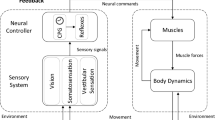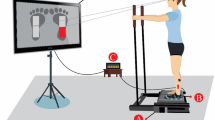Abstract
Studies on the proactive control of gait have shown that proximal (hip/trunk) muscles are the primary contributors to balance control, while studies on reactive balance control during perturbed gait, examining only activity in distal (leg/thigh) muscles, have shown that these muscles are important in compensating for a gait disturbance. This study tested the hypothesis that proximal muscles are also primary contributors to reactive balance control during perturbed gait. Thirty-three young adults participated in a study in which an anterior slip was simulated at heel strike by the forward displacement of a force plate on which they walked. Surface electromyographic data were recorded from bilateral leg, thigh, hip and trunk muscles. Kinematic data were collected on joint angle changes in response to the perturbation. The results did not support the hypothesis that the proximal muscles contribute significantly to balance control during perturbed gait. The proximal muscles did not demonstrate more consistent activation, earlier onset latency, longer burst duration or larger burst magnitude than distal muscles. Moreover, although proximal postural activity was often present in the first slip trial, it tended to adapt away in later trials. By contrast, the typical postural responses exhibited by young adults consisted of an early (90–140 ms), high-magnitude (4–9 times muscle activity during normal walking) and relatively long duration (70–200 ms) activation of bilateral anterior leg muscles as well as the anterior and posterior thigh muscles. Thus, postural activity from bilateral leg and thigh muscles and the coordination between the two lower extremities were the key to reactive balance control and were sufficient for regaining balance within one gait cycle. The adaptive attenuation of proximal postural activity over repeated trials suggests that the nervous system overcompensates for a novel balance threat in the first slip trial and fine-tunes its responses with experience.
Similar content being viewed by others
Author information
Authors and Affiliations
Additional information
Received: 24 March 1997 /Accepted: 4 September 1997
Rights and permissions
About this article
Cite this article
Tang, PF., Woollacott, M. & Chong, R. Control of reactive balance adjustments in perturbed human walking: roles of proximal and distal postural muscle activity. Exp Brain Res 119, 141–152 (1998). https://doi.org/10.1007/s002210050327
Issue Date:
DOI: https://doi.org/10.1007/s002210050327




